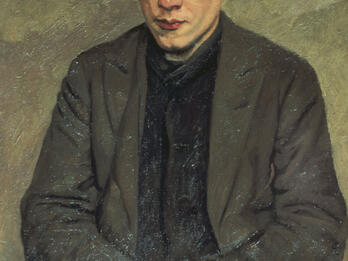Elijah’s Chair
Ze’ev Raban
1925
Image

Engage with this Source
Creator Bio
Ze’ev Raban
1890–1970
The painter and decorative artist Ze’ev Raban (originally Wolf Rawicki) was born in Łódź, where he initially studied art; he continued his training in Munich and Brussels, where the influence of art nouveau was then at its zenith. He settled in Jerusalem in 1912 and joined the faculty of the Bezalel School of Arts and Crafts; most of the objects produced in its workshops between 1914 and 1929 were of his design. His style combined elements of art nouveau with motifs from traditional Syrian and Persian art. In addition to his striking and erotically charged art-nouveau works on biblical themes in a Jewish secular-national and Zionist vein, Raban also created the decorative elements for such well-known Jerusalem buildings as the King David Hotel and the YMCA, and designed a wide variety of everyday objects, including playing cards, banknotes, tourism posters, jewelry, commercial packaging, and Zionist insignia.
You may also like

Costume Design (Bearded Male) for Peretz’s At Night in the Old Marketplace
The Russian Revolution initially lifted restrictions on Jewish publishing, sparking a burst of creativity among Jewish writers and artists. Jewish theater companies experimented with modernist…

Barnett Freedman
Rothenstein was one of the best-known and most prolific British portraitists of the first half of the twentieth century. His style confounds easy characterization. He considered himself both a…

Entering to House of Prayer
Steinhardt was one of the founders of a group of artists in Berlin called Die Pathetiker (The Sorrowful Ones), early practitioners of what later came to be known as expressionism. Expressionists…

Poet Avraham Shlonsky
Tagger was a member of what is known as the Land of Israel movement, a group of artists who, in the 1920s, broke with the conventions of the Bezalel School of Arts and Crafts. They drew on the ideas…

New York
New York exemplifies the precisionist, futurist style favored by Lozowick in the 1920s. Like works by other precisionist artists, this lithograph reduces the elements of a cityscape into simple…

Two Jews
Early in his career, Castel often painted pictures of Jews, like these, whose roots were in Arab lands. Many at the Bezalel School of Arts and Crafts, where he studied, believed that Yemenite Jews…

